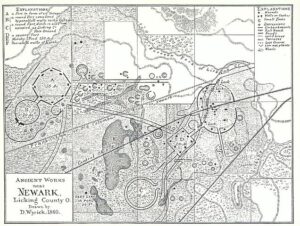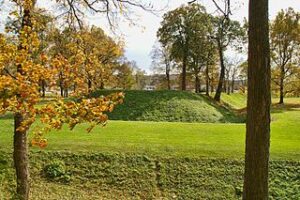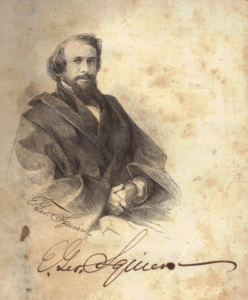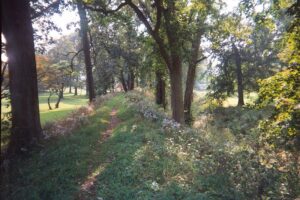
Newark Earthworks, Ohio, built by the Hopewell culture from 100 BC to 500 AD.21 August 2009, photo Jubileejourney, CCA-SA 3.0 Unported license.
A legal and public relations battle lasting more than 20 years over a unique complex of Native American earthworks has ended, with an Ohio Supreme Court decision in 2023 and a negotiated settlement agreement announced August 1, 2024.
The Octagon Earthworks in Newark, Ohio have undergone remarkable transformations over the past century. The Octagon Earthworks are a part of the Newark Earthworks, a sprawling 4.5-square-mile complex of interconnected mounds, geometric berms, and embankments built by the Hopewell Culture between 1,600 and 2,000 years ago. The complex once covered approximately 3,000 acres. Today, less than 10 percent of the original site remains preserved, totaling 206 acres. The Newark Earthworks Great Circle, located in Heath, Ohio, is one of the largest circular earthworks in the Americas, with a 1200 foot diameter. It forms a shallow moat surrounded by walls that rise to 8 feet in height. The 50-acre Octagon Earthworks at the site of the current golf club, featuring eight long earthen walls, were meticulously aligned with lunar movements and may have been an important Native American ceremonial center.
In 2006, the Newark Earthworks were recognized as Ohio’s “official prehistoric monument.” The Octagon and Great Circle Earthworks were, and still are, managed by an Ohio state agency, the Ohio History Connection (OHC), formerly the Ohio State Historical Society. But the earthworks lay, in fact, within the grounds of a private golf club, the Moundbuilders Country Club. The club, which describes itself as a traditional local, blue-collar organization, had leased the land from a prior owner since 1910. The land was later acquired by the Ohio State Archeological and Historical Society. In 1997, the Historical Society had signed a lease with the club that did not expire until 2078. However, in late 2023, the Ohio Supreme Court allowed the taking of the land by the state under eminent domain.
After more than a decade of campaigning by the U.S. Department of the Interior, the Hopewell Ceremonial Earthworks were designated as a UNESCO World Monument in 2023. The delay in designation was not based on any doubt about their importance as an extraordinary ancient monument of world culture. It was because privately managed monuments do not qualify for World Monument status.

Newark Ohio Drawing by D. Wyrick in 1860 – Ancient Works. Public domain.
What makes the Octagon Earthworks unique is that its earthen mounds and embankments functioned as an ancient astronomical observatory. In 1982, researchers from Earlham College in Richmond, Indiana realized that the earthworks formed an ancient lunar observatory designed to track the motions of the moon. When the moon is at the northernmost point of the 18.6-year cycle of its lunar orbit, it rises within one-half of a degree of the octagon’s exact center, when seen from the observatory mound. In comparison to the possible observatory functions of the Stonehenge complex, the Newark earthworks may be twice as precise. Earlham history professor Ray Hively, together with philosophy professor Robert Horn, analyzed the earthworks’ design. According to Hively, it likely functioned as a ceremonial site involving Native American beliefs regarding the moon. Archaeological discoveries at the site have unearthed raw materials originating as far west as the Rocky Mountains, indicating that the earthworks may have attracted Native peoples from across the continent. Cambridge University archaeologist Chris Scarre described the Newark Earthworks one of the 70 wonders of the ancient world. The site is now the State of Ohio’s first and only UNESCO World Heritage Site.
HOW AN ANCIENT INDIAN MONUMENT BECAME A GOLF COURSE

Newark Earthwork Web Map, Digitized for “Virtual World Heritage Ohio”, Funded through grant number HAA-269032-20 National Endowment for the Humanities: Digital Humanities Advancement Grant (NEH DHAG). Contributors for this project include Jennifer Aultman, Trevor Danehy, Meghan Federer, John Fillwalk, Ina-Marie Johnstron, Adam Kobitz, Bradley Lepper, Kevin Nolan, David Rodriguez, Neil Zehr, Jade Moore, and Tusher Mohanta.
When the Ohio History Connection sought return of the ancient monument to public control, the Moundbuilders Country Club, which had leased the land for a century, fought to retain its semi-private status (public visitors were allowed only on Mondays). The club argued that the ancient structures were well preserved (no carts were allowed off the paths that snaked around the walls and mounds) and that the club served ordinary American working families, not a privileged elite. However, a series of hard fought cases all the way to the Ohio Supreme Court finally resulted in a turnover to the state. An undisclosed financial settlement agreement was recently announced between the club and the Ohio History Connection.
The Ohio History Connection is now finalizing plans to make the site publicly accessible. It will open on January 1, 2025. The organization’s president, Charles R. Moses, described the monument as “part cathedral, part cemetery, and part astronomical observatory,” rejoicing that it will now be “fully open to the citizens of Ohio – and the world.”
The Octagon Earthworks land was privately owned until 1892, when the Newark Board of Trade acquired the property on behalf of the state in order to preserve the ancient structures. Funding for the purchase came from bonds issued by the city of Newark and Licking County. The property deeds specified that the land would serve as a permanent camping ground for the Ohio National Guard, which used the site until 1908.
In 1910, the Newark Board of Trade, the city of Newark, and Licking County leased the property to the Licking Country Club Company. A year later, the club renamed itself Moundbuilders Country Club and built a golf course on the property, with the stipulation that the public would still have access to the historic earthworks.
A golf course of nine holes was originally designed around the mounds and earthwork walls by Thomas Bendelow, a pioneering Scottish architect of golf courses who came to America in the 1880s and began laying out courses in New York. Bendelow laid out hundreds of golf courses during his career. The planning was not extensive, generally costing $25 and taking just one day to lay out a 9-hole course. The Moundbuilders course first opened in 1911; in 1923 it was expanded to 18 holes.

The Newark Octagon as enshrined in the Hopewell Ceremonial Earthworks UNESCO World Heritage Site, Ohio, 1 Nov. 2021, NPS, public domain.
In 1933, ownership of the property was transferred to the Ohio State Archeological and Historical Society, an organization dedicated to Ohio history, now known as the Ohio History Connection or OHC. Over the years, the OHC has renewed the lease with Moundbuilders Country Club. Under an agreement with the golf club, the public was granted free access to the Country Club on Mondays only. A designated visitation area and observation platform was also set up to allow the public to view a portion of the earthworks.In 2013, the OHC began a long and arduous journey to reclaim the site. In January 2013, the OHC initiated negotiations to re-acquire the lease and provide full public access to the Octagon Earthworks.
This effort gained momentum in 2018, when the federal government invited the Ohio History Connection and the National Park Service to jointly apply for UNESCO World Heritage Site designation for a group of eight Ohio earthworks known as the Hopewell Ceremonial Earthworks. (The first request for this classification had been made by the Department of the Interior in 2008.) This group includes the Octagon Earthworks and the Great Circle Earthworks in Newark. To qualify for the international designation, the Octagon Earthworks site had to be fully under public control, not managed by a private entity. In August 2018, the Ohio History Connection reached out to Moundbuilders Country Club to negotiate an agreement for the club to relinquish the remaining time on its lease.

Newark earthworks, photo by Niagara66, 16 October 2011, CCA-SA 4.0 International license.
When the OHC and the golf club failed to agree on buying out the lease, the OHC filed a court case to obtain the lease and take the land through eminent domain. The legal battle was intense, with the Licking County Common Pleas Court ruling in May 2019 that the OHC had the authority to acquire the lease for public use. This decision was later upheld by the Fifth District Court of Appeals, which enabled the state agency to nominate the structures to the World Heritage list as part of the interconnected Hopewell Ceremonial Earthworks.
The case eventually reached the Ohio Supreme Court on final appeal by the golf club. (See State ex rel. Ohio History Connection v. Moundbuilders Country Club Co., 171 Ohio St.3d 663, 2022-Ohio-4345.) On December 7, 2022, a majority of the Ohio Supreme Court upheld the lower court’s decisions granting the OHC the right to reclaim the lease held by the Moundbuilders Country Club. The author of the opinion, Justice Michael P. Donnelly, stated that making the earthworks into a public park would “help preserve and ensure perpetual public access to one of the most significant landmarks in the state of Ohio.” In a dissenting opinion, Justice Sharon L. Kennedy stated that under court precedent, it was improper to take land through public domain if the future public use as a World Heritage site was “contingent and prospective,” and the current private use was “actual and present.”

Newark Mounds, Ohio, Photo by Carptrash, ca. 1980s. Thanks to Phil Koszarek, pilot.
A jury trial to determine the fair market value of the lease was scheduled for October 2023, but negotiations continued that ultimately led to a settlement. A key point of contention between the country club and the OHC was the issue of compensation for the club to relocate. The OHC offered between $1 million and $2 million as a buyout, but club officials argued that relocating the club could cost as much as $25 million.
On August 1, 2024, the OHC and the Moundbuilders Country Club announced they had reached an agreement, with the club accepting a confidential sum to terminate its lease. This settlement averted the need for a jury trial and marked the end of a decade-long effort to open the site to public access. The actual amount of the settlement has not been made public. There has been no announcement yet of the future of the club or whether it received sufficient funds to establish new grounds elsewhere.
EARLY STUDIES ON THE EARTHWORKS ESTABLISHED ITS IMPORTANCE

Print by CW of Ephraim George Squier, signed by Squier and presented to N W Bell c. 1870 – 1880.
The Newark Earthworks, located in Newark and Heath, Ohio, comprise three preserved sections: the Great Circle Earthworks, the Octagon Earthworks, and the Wright Earthworks. Built by the Hopewell culture between 100 BCE and 400 CE, the Earthworks complex was among the Native American ancient monuments identified and surveyed for the Smithsonian Institution in the mid-nineteenth century by Ephraim G. Squier and Edwin Hamilton Davis between 1837 and 1847. Their book, Ancient Monuments of the Mississippi Valley, was the first volume in the Smithsonian Institution’s Contributions to Knowledge series, the Institution’s first publication.
This study was a milestone in American scientific research and marked the early development of archaeology as a scientific discipline. The book featured Squier and Davis’ detailed and measured plans of the site, still used to complement and clarify today’s aerial digital renderings.
THE FUTURE OF THE GOLF COURSE
Historically, the Moundbuilders Country Club has been careful to preserve the mounds; it says that the main dangers lie in public usage that might bring thousands of visitors to the site. However, the legal issues first arose when the club sought permission for a new building more than twenty years ago; the plan would have required digging into an existing earthwork wall and prompting the historical society to bring the history and importance of the earthworks to public and federal government attention.
“We wouldn’t want a country club on the Acropolis,” said John N. Low, director of the Newark Earthworks Center and a citizen of the Pokagon Band of Potawatomi, told the press. “We don’t want a country club on the Octagon.”

Great Circle Earthworks. Photo by Ebyabe, 27 September 2004. CCA-SA 3.0 license.
The club points to its own century-old traditions. “The ancient Moundbuilders unwittingly left behind the setting for as strange and sporty a golf course as ever felt the blow of a niblick,” proclaimed proclaimed an article about the course in the January 1930 issue of Golf Illustrated. Golf aficionados say that the course is medium difficult, though “no one would ever confuse it for the nearby Jack Nicklaus’s Muirfield Village Golf Club.” The mounds are a more formidable obstacle than they first appear. “It’s hard to shoot what you normally shoot here,” a member told the press.
No announcement has yet been made regarding the future of the club and whether there will be an attempt to acquire other property and create a course elsewhere around Newark. Earlier, the Chairman of the Board of Trustees of the Club, David Kratoville expressed the frustration felt by the club, which has preserved the site for 100 years: ““We respect what they want to do but they need to respect that we’ve occupied and improved this property and if they want it back, they simply need to pay us the amount of money required for us to move. We would prefer to stay but we’re willing to recreate or relocate. They simply need to pay us enough money so we can go and do that.” The club has not offered any comment since the settlement was announced.
 Great Circle Earthworks: Aerial View
© Ohio History Connection, Author: Bradley T. Lepper, UNESCO.
Great Circle Earthworks: Aerial View
© Ohio History Connection, Author: Bradley T. Lepper, UNESCO.


